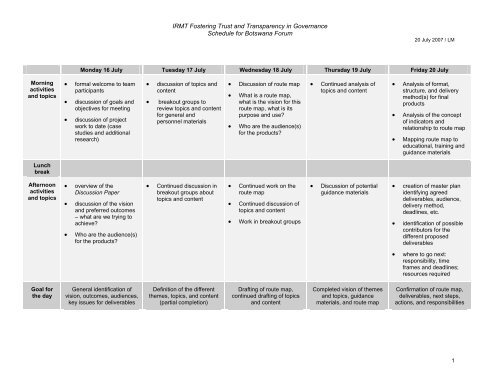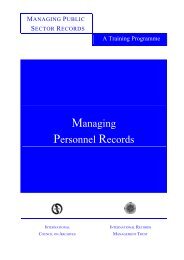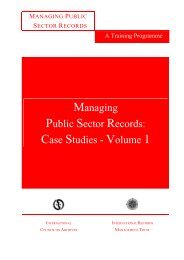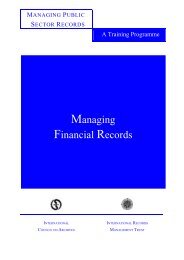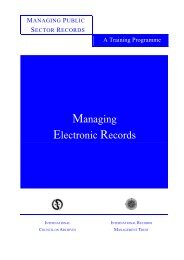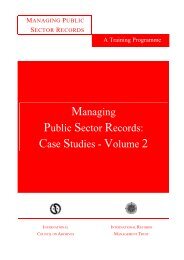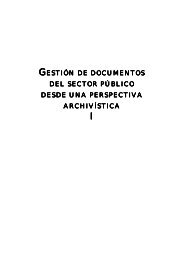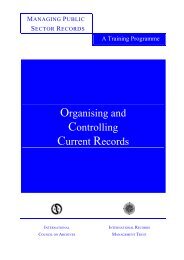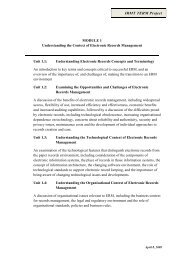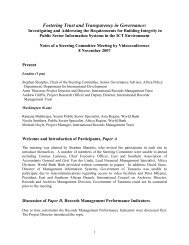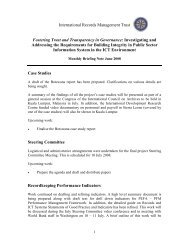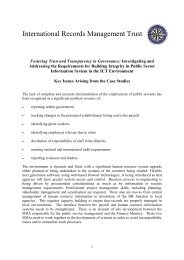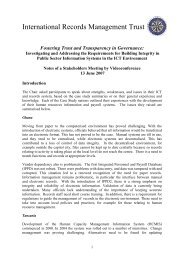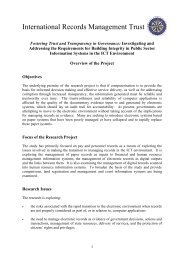Notes and Decisions - International Records Management Trust
Notes and Decisions - International Records Management Trust
Notes and Decisions - International Records Management Trust
Create successful ePaper yourself
Turn your PDF publications into a flip-book with our unique Google optimized e-Paper software.
Morning<br />
activities<br />
<strong>and</strong> topics<br />
Lunch<br />
break<br />
Afternoon<br />
activities<br />
<strong>and</strong> topics<br />
Goal for<br />
the day<br />
IRMT Fostering <strong>Trust</strong> <strong>and</strong> Transparency in Governance<br />
Schedule for Botswana Forum<br />
20 July 2007 / LM<br />
Monday 16 July Tuesday 17 July Wednesday 18 July Thursday 19 July Friday 20 July<br />
• formal welcome to team<br />
participants<br />
• discussion of goals <strong>and</strong><br />
objectives for meeting<br />
• discussion of project<br />
work to date (case<br />
studies <strong>and</strong> additional<br />
research)<br />
• overview of the<br />
Discussion Paper<br />
• discussion of the vision<br />
<strong>and</strong> preferred outcomes<br />
– what are we trying to<br />
achieve?<br />
• Who are the audience(s)<br />
for the products?<br />
General identification of<br />
vision, outcomes, audiences,<br />
key issues for deliverables<br />
• discussion of topics <strong>and</strong><br />
content<br />
• breakout groups to<br />
review topics <strong>and</strong> content<br />
for general <strong>and</strong><br />
personnel materials<br />
• Continued discussion in<br />
breakout groups about<br />
topics <strong>and</strong> content<br />
Definition of the different<br />
themes, topics, <strong>and</strong> content<br />
(partial completion)<br />
• Discussion of route map<br />
• What is a route map,<br />
what is the vision for this<br />
route map, what is its<br />
purpose <strong>and</strong> use?<br />
• Who are the audience(s)<br />
for the products?<br />
• Continued work on the<br />
route map<br />
• Continued discussion of<br />
topics <strong>and</strong> content<br />
• Work in breakout groups<br />
Drafting of route map,<br />
continued drafting of topics<br />
<strong>and</strong> content<br />
• Continued analysis of<br />
topics <strong>and</strong> content<br />
• Discussion of potential<br />
guidance materials<br />
Completed vision of themes<br />
<strong>and</strong> topics, guidance<br />
materials, <strong>and</strong> route map<br />
• Analysis of format,<br />
structure, <strong>and</strong> delivery<br />
method(s) for final<br />
products<br />
• Analysis of the concept<br />
of indicators <strong>and</strong><br />
relationship to route map<br />
• Mapping route map to<br />
educational, training <strong>and</strong><br />
guidance materials<br />
• creation of master plan<br />
identifying agreed<br />
deliverables, audience,<br />
delivery method,<br />
deadlines, etc.<br />
• identification of possible<br />
contributors for the<br />
different proposed<br />
deliverables<br />
• where to go next:<br />
responsibility, time<br />
frames <strong>and</strong> deadlines;<br />
resources required<br />
Confirmation of route map,<br />
deliverables, next steps,<br />
actions, <strong>and</strong> responsibilities<br />
1
Introductory <strong>Notes</strong><br />
IRMT Fostering <strong>Trust</strong> <strong>and</strong> Transparency in Governance<br />
Snapshot of Groupings of Themes<br />
20 July 2007 / LM<br />
• See the audience chart for clarification of who is the anticipated audience for the educational <strong>and</strong> training materials to be designed. These<br />
materials assume that the people being educated already know key <strong>and</strong> basic records <strong>and</strong> archives management principles. For example,<br />
they may already have certificates in records management, archives management, or information management; they may have preappointment<br />
education; they may have taken a series of workshops or courses on records <strong>and</strong> information management through<br />
professional associations etc.; or they may have X years of previous work experience directly in records or archives management at a<br />
middle skill level, not a support position.<br />
• We could develop a list of key skill <strong>and</strong> knowledge areas that they must have acquired prior to taking this programme, <strong>and</strong> we may<br />
develop a questionnaire or quiz to assess their capacity <strong>and</strong> knowledge. Are they competent to participate significantly in the management<br />
of a paper-based records programme <strong>and</strong> must have basic computer literacy?<br />
• We will need to clarify if they have records experience as well as archives experience, as we expect that they should have worked in a<br />
current records environment not just in a ‘traditional’ archives environment.<br />
<strong>Notes</strong> on Delivery Issues<br />
• Discussion of general vision for all materials. There was a discussion of posting information on a web page, also making it available in<br />
paper form. Will everything be web based? Also paper based? If web-based, you could link resources with educational materials <strong>and</strong> join<br />
up the materials as you want. The linearity of previous materials such as MPSR doesn’t have to be.<br />
• What are the resource issues of maintaining the material once it is created?<br />
• Should guidance materials be st<strong>and</strong> alones? General agreement that yes they should be st<strong>and</strong> alones. Both print <strong>and</strong> electronic.<br />
• Link the route map to the educational <strong>and</strong> training materials so that they are all connected on the web environment.<br />
• The route map is going to need contextual information. An explanation of the route map is going to have to be constructed. What it is <strong>and</strong><br />
what it is for. Explanation of pre-requisites in order to start using this route map.<br />
2
IRMT Fostering <strong>Trust</strong> <strong>and</strong> Transparency in Governance<br />
Snapshot of Groupings of Themes<br />
20 July 2007 / LM<br />
• Educational <strong>and</strong> training materials: will they be put out electronically in PDF <strong>and</strong> Word so that they are easily usable. HTML? Is there a<br />
vision of interactivity <strong>and</strong> hyper-linking. Issues of cost <strong>and</strong> what works best in developing countries. Preference for PDF <strong>and</strong> HTML.<br />
• Issue of level of instructional design an important question. Is there an issue of interactive learning? What should be the level of<br />
instructional design?<br />
• Should there be elements of instructional design for teaching the content: electronic records management? Therefore, include<br />
examples, study questions, <strong>and</strong> training materials related to content AND instructional design around train the trainers issues? General<br />
sense of no.<br />
• General discussion of a focus on content of materials, with less emphasis on the instructional design component. The assumption would<br />
have to be that the materials would be available to records professionals <strong>and</strong> educators but they would be expected to take the content<br />
<strong>and</strong> develop their own educational or training environment for use <strong>and</strong> delivery of those materials. Our job is not to create courses for train<br />
the trainers but courses on electronic records management content so that trainers can adapt <strong>and</strong> use them in their own circumstances.<br />
• Ideally we would avoid ‘flat’ presentation of content. But there are cost issues <strong>and</strong> time issues. What is the capacity in developing<br />
countries to use more interactive materials? We need to focus more on content <strong>and</strong> relatively simple formats.<br />
• What about the need to teach electronic records management through some exposure to electronic records issues <strong>and</strong> examples – how<br />
would we teach electronic records management in a paper-based environment?<br />
• Do we need to forge partnerships with delivery agencies, such as universities, public sector colleges, or other mediated environments, so<br />
that they can develop the instructional components? What happens when the materials are used in the work place <strong>and</strong> there is not the<br />
capacity to teach electronically but we are teaching electronic records in a paper environment?<br />
• Will there be other interventions coming from other sources? If we produce the written materials will colleges <strong>and</strong> universities take this<br />
on <strong>and</strong> adapt <strong>and</strong> use it for their own means?<br />
• What is the relationship of this material to the MPSR electronic records information? Should it be pulled from the website? Should we<br />
pull it from the website? Probably yes.<br />
• Recognition of the value of drawing on existing materials but also the importance of (1) creating materials relevant to the intended<br />
audiences, especially in developing countries, <strong>and</strong> (2) not entering into complicated negotiations <strong>and</strong> agreements to use specific materials<br />
‘in toto’ when they might be better used as resources <strong>and</strong> research for writing new material relevant to the specific project.<br />
3
E<br />
D<br />
U<br />
C<br />
A<br />
T<br />
I<br />
O<br />
N<br />
A<br />
L<br />
/<br />
T<br />
R<br />
A<br />
I<br />
N<br />
I<br />
N<br />
G<br />
T<br />
O<br />
O<br />
L<br />
S<br />
IRMT<br />
<strong>Records</strong> Professionals,<br />
National Archivists <strong>and</strong><br />
Educators<br />
ICT Professionals<br />
<strong>and</strong> Educators<br />
IRMT Fostering <strong>Trust</strong> <strong>and</strong> Transparency in Governance<br />
Snapshot of Groupings of Themes<br />
G U I D A N C E M A T E R I A L S<br />
<strong>Records</strong> Staff<br />
<strong>Records</strong> Creators<br />
<strong>and</strong> Users<br />
Systems Personnel<br />
Senior<br />
Managers<br />
Auditors<br />
Legal<br />
Representatives<br />
<strong>and</strong> Advisors<br />
20 July 2007 / LM<br />
Governments,<br />
Donors <strong>and</strong> Funders<br />
Civil Society<br />
The Public<br />
4
CONTEXT OF ELECTRONIC RECORDS<br />
MANAGEMENT<br />
1: Concepts <strong>and</strong> Social Context<br />
2: Business <strong>and</strong> Organisational<br />
Context<br />
3: Technological Context<br />
IRMT Fostering <strong>Trust</strong> <strong>and</strong> Transparency in Governance<br />
Snapshot of Groupings of Themes<br />
PLANNING ELECTRONIC RECORDS<br />
MANAGEMENT PROGRAMS<br />
4: Policy <strong>and</strong> Planning<br />
5: Advocating electronic records<br />
management<br />
10: Technological Issues <strong>and</strong><br />
Solutions<br />
IMPLEMENTING ELECTRONIC<br />
RECORDS MANAGEMENT<br />
PROGRAMS<br />
6: <strong>Records</strong> Appraisal <strong>and</strong> Disposal<br />
7: <strong>Records</strong> Creation, Capture & Use<br />
8: <strong>Records</strong> Access<br />
9: Preservation<br />
20 July 2007 / LM<br />
DEVELOPING PERSONNEL,<br />
ESTABLISHMENT AND PAYROLL<br />
INFORMATION SYSTEM<br />
11. Personnel, Establishment <strong>and</strong><br />
Payroll Information Systems<br />
5
1: Concepts <strong>and</strong> Social Context 2: Business <strong>and</strong> Organisational<br />
Context<br />
1 Underst<strong>and</strong>ing definitions <strong>and</strong><br />
terminology<br />
2 Underst<strong>and</strong>ing electronic records<br />
concepts<br />
3 Underst<strong>and</strong>ing governance<br />
concepts<br />
4 Examining the challenges of<br />
electronic records management<br />
5 Examining the opportunities of<br />
electronic records management<br />
6 Considering the transition to<br />
electronic records<br />
5: Advocating electronic records<br />
management<br />
1 Learning advocacy skills<br />
2 Selling records management<br />
IRMT Fostering <strong>Trust</strong> <strong>and</strong> Transparency in Governance<br />
Overview of Themes <strong>and</strong> Topics<br />
1 Underst<strong>and</strong>ing organisational<br />
infrastructure<br />
2 Underst<strong>and</strong>ing the legal <strong>and</strong><br />
regulatory environment<br />
3 Underst<strong>and</strong>ing technological<br />
capacity<br />
4 Underst<strong>and</strong>ing st<strong>and</strong>ards<br />
5 Underst<strong>and</strong>ing business processes<br />
6 Conducting a records survey<br />
7 Conducting a needs assessment<br />
3: Technological Context 4: Policy <strong>and</strong> Planning<br />
1 Underst<strong>and</strong>ing the technological<br />
infrastructure<br />
2 Record keeping functionality of<br />
business systems<br />
3 Underst<strong>and</strong>ing the transition from<br />
the paper <strong>and</strong> analogue to digital<br />
4 Staying on top of technological<br />
issues<br />
20 July 2007 / LM<br />
1 Developing a policy<br />
2 Developing a business case<br />
3 How to plan<br />
4 Underst<strong>and</strong>ing change<br />
management<br />
5 Developing a training <strong>and</strong> capacity<br />
building program<br />
6 How to obtain <strong>and</strong> manage<br />
resources<br />
7 How to measure performance <strong>and</strong><br />
achievements<br />
6: <strong>Records</strong> Appraisal <strong>and</strong> Disposal 7: <strong>Records</strong> Creation, Capture & Use 8: <strong>Records</strong> Access<br />
1 Concepts of appraisal <strong>and</strong> disposal<br />
2 Developing appraisal policies<br />
3 Implementation<br />
1 Concepts of an electronic records<br />
management system<br />
2 Capturing records into a record<br />
keeping system<br />
3 Underst<strong>and</strong>ing <strong>and</strong> applying naming<br />
conventions<br />
4 Underst<strong>and</strong>ing <strong>and</strong> capturing<br />
metadata<br />
5 Developing a classification scheme<br />
6 Developing a records retention <strong>and</strong><br />
disposition schedule<br />
1 Concepts of access<br />
2 Developing access policies<br />
3 Implementation<br />
6
9: Preservation 10: Technological Issues <strong>and</strong><br />
Solutions<br />
1 Concepts of preservation<br />
2 Developing preservation policies<br />
3 Implementation<br />
4 Options <strong>and</strong> future directions<br />
IRMT Fostering <strong>Trust</strong> <strong>and</strong> Transparency in Governance<br />
Overview of Themes <strong>and</strong> Topics<br />
1 Making the transition to an<br />
electronic records management<br />
environment<br />
2 How to select solutions<br />
3 How to plan the rollout of an<br />
electronic records management<br />
system<br />
4 Procurement issues<br />
20 July 2007 / LM<br />
11. Developing Personnel, Establishment <strong>and</strong> Payroll Information Systems<br />
1 Context of personnel <strong>and</strong> payroll<br />
records management<br />
2 Personnel management business<br />
processes<br />
3 Business process re-engineering<br />
4 Underst<strong>and</strong>ing personnel functions<br />
5 Personnel records in centralised<br />
<strong>and</strong> decentralised environments<br />
6 Personnel files in paper <strong>and</strong><br />
electronic formats<br />
7 Managing personal files<br />
8 ICT <strong>and</strong> personnel records<br />
management<br />
7
Theme 1: Concepts <strong>and</strong> Social Context<br />
IRMT Fostering <strong>Trust</strong> <strong>and</strong> Transparency in Governance<br />
Analysis of Themes <strong>and</strong> Topics<br />
20 July 2007 / LM<br />
No. Topic Description Comments Links to Route Map<br />
1 Underst<strong>and</strong>ing definitions <strong>and</strong> terminology Definitions of records management terms Focusing specifically on<br />
ER <strong>and</strong> assuming preexisting<br />
knowledge of core<br />
archives <strong>and</strong> records<br />
terminology<br />
2 Underst<strong>and</strong>ing electronic records concepts Issues such as authenticity, reliability,<br />
integrity, mutability, etc.<br />
3 Underst<strong>and</strong>ing governance <strong>and</strong> development<br />
concepts<br />
4 Examining the challenges of electronic records<br />
management<br />
5 Examining the opportunities of electronic records<br />
management<br />
Issues such as accountability,<br />
transparency, good governance, FOI,<br />
privacy, compliance, address issues<br />
linking records management to objectives<br />
for development <strong>and</strong> electronic<br />
government, underst<strong>and</strong>ing the transition<br />
to e-government<br />
Introduction to issues such as changes in<br />
technology, different products, transitory<br />
nature, everyone his own record keeper,<br />
dependence on availability of hardware<br />
<strong>and</strong> software, cost, can you read it without<br />
mediation, security <strong>and</strong> privacy issues with<br />
vulnerable records; who has access,<br />
underst<strong>and</strong>ing the digital divide<br />
Introduction to issues such as widespread<br />
access, flexibility, efficiency, effectiveness,<br />
economy, general business opportunities<br />
6 Considering the transition to electronic records Examining issues related to making the<br />
transition to electronic records,<br />
underst<strong>and</strong>ing the reality <strong>and</strong> viability of<br />
hybrid paper-electronic systems<br />
Question of introducing<br />
concepts <strong>and</strong> providing an<br />
overview but leaving more<br />
detailed learning until later<br />
Guidance note on<br />
relationship between<br />
records <strong>and</strong> accountability?<br />
Indicating that there is a<br />
way forward, don’t be<br />
afraid – we will find a way<br />
through this issue<br />
Cross reference to theme<br />
3, what is the crossover<br />
between themes 1 & 3?<br />
Guidance note on the<br />
transition to electronic<br />
records?<br />
Route Map No 1<br />
No direct route map<br />
links<br />
No direct route map<br />
links<br />
Route Map No 4<br />
Route Map No 4<br />
Route Map No 4<br />
8
Theme 2: Business <strong>and</strong> Organisational Context<br />
IRMT Fostering <strong>Trust</strong> <strong>and</strong> Transparency in Governance<br />
Analysis of Themes <strong>and</strong> Topics<br />
20 July 2007 / LM<br />
No. Topic Description Comments Links to Route Map<br />
1 Underst<strong>and</strong>ing organisational infrastructure Who you work for, what do they do, how<br />
do they set about doing it, mission, vision,<br />
values, culture, money, resources, also<br />
consider objectives, goals<br />
2 Underst<strong>and</strong>ing the legal <strong>and</strong> regulatory<br />
environment<br />
Need for a legal environment, how to do<br />
the research, what issues might be<br />
identified, what is the rationale behind<br />
your existence as an organisation<br />
3 Underst<strong>and</strong>ing technological capacity What has the organisation got, what has<br />
the country got, what can you achieve,<br />
network capacity of the country, etc.;<br />
underst<strong>and</strong>ing how the organisation works<br />
to develop its technological capacity<br />
4 Underst<strong>and</strong>ing st<strong>and</strong>ards Record keeping, ICT, <strong>and</strong> related<br />
st<strong>and</strong>ards<br />
5 Underst<strong>and</strong>ing business processes Background analysis, research <strong>and</strong><br />
development, analysing business<br />
processes<br />
Procurement at highest<br />
level?<br />
How does this topic relate to<br />
Theme 3, especially 3.1<br />
6 Conducting a records survey How to do a records survey skills development issue<br />
here<br />
7 Conducting a needs assessment Including high-level requirements<br />
specifications<br />
Route Map No 2<br />
Route Map No 2<br />
Route Map No 2<br />
Route Map No 2<br />
Route Map No 2<br />
Route Map No 13<br />
Route Map No 5<br />
Route Map No 2<br />
Route Map No 13<br />
9
Theme 3: Technological Context<br />
IRMT Fostering <strong>Trust</strong> <strong>and</strong> Transparency in Governance<br />
Analysis of Themes <strong>and</strong> Topics<br />
20 July 2007 / LM<br />
No. Topic Description Comments Links to Route Map<br />
1 Underst<strong>and</strong>ing the technological infrastructure Shared drives, ERM/EDM/ERK systems,<br />
email management, voice mail<br />
management, desktop management, web<br />
records (<strong>and</strong> wikis <strong>and</strong> blogs), database<br />
formats) , technology watch, IT security,<br />
firewalls etc.,<br />
2 Record keeping functionality of business systems The question of human resources<br />
systems, line of business systems,<br />
financial systems, <strong>and</strong> the questions of<br />
whether they are or not record keeping<br />
systems <strong>and</strong> whether they have record<br />
keeping functionality<br />
3 Underst<strong>and</strong>ing the transition from the paper <strong>and</strong><br />
analogue to digital<br />
Including paper to electronic records,<br />
analogue records such as microform,<br />
audio, video, to digital environment,<br />
scanning issues; as businesses develop<br />
to e-businesses, how does record keeping<br />
fit into e-business<br />
Underst<strong>and</strong>ing hybrid environments/hybrid<br />
records<br />
Underst<strong>and</strong>ing the role <strong>and</strong> nature of<br />
legacy records, <strong>and</strong> that they need to be<br />
cared with in the transition to an electronic<br />
environment<br />
Choosing file formats, PDF<br />
versus XML – discuss here?<br />
Revisiting the digital divide;<br />
consider cross over with<br />
Theme 1<br />
There is a real issue of<br />
digitisation as seen as a<br />
major solution but perhaps<br />
digitisation projects are not<br />
being managed well: we<br />
need to (1) address the<br />
nature <strong>and</strong> role of<br />
digitisation – in Theme 3? –<br />
<strong>and</strong> then say if you want to<br />
go ahead here is how you<br />
should do it.<br />
Route Map No 2<br />
Route Map No 13<br />
Route Map No 4<br />
Route Map No 15<br />
4 Staying on top of technological issues Research <strong>and</strong> development Route Map No 17<br />
10
Theme 4: Policy <strong>and</strong> Planning<br />
IRMT Fostering <strong>Trust</strong> <strong>and</strong> Transparency in Governance<br />
Analysis of Themes <strong>and</strong> Topics<br />
20 July 2007 / LM<br />
No. Topic Description Comments Links to Route Map<br />
1 Developing a policy Issues of developing a policy Route Map No 1<br />
2 Developing a business case Risk/benefit analysis, selling records<br />
management (introductory to the<br />
advocacy theme)<br />
3 How to plan Why plan, planning for electronic records,<br />
developing a plan<br />
4 Underst<strong>and</strong>ing change management How to change, why to change, how to<br />
measure change<br />
5 Developing a training <strong>and</strong> capacity building<br />
program<br />
Training <strong>and</strong> capacity building for users,<br />
managers, implementers, all the<br />
stakeholders, or is it for records personnel<br />
delivering the training program<br />
Skills development needed<br />
for business case planning<br />
Discuss how to cope with<br />
social engineering – what to<br />
do when people won’t pay<br />
attention or organisations<br />
don’t comply<br />
For potentially any <strong>and</strong> all of<br />
the audiences in the chart,<br />
who might be receptive to<br />
training<br />
Route Map No 4<br />
Route Map No 14<br />
Route Map No 3<br />
Route Map No 14<br />
Route Map No 6<br />
6 How to obtain <strong>and</strong> manage resources Route Map No 7<br />
7 How to measure performance <strong>and</strong> achievements Route Map No 4<br />
Route Map No 16<br />
Theme 5: Advocating Electronic <strong>Records</strong> <strong>Management</strong><br />
No. Topic Description Comments Links to Route Map<br />
1 Learning advocacy skills Public speaking, empowerment,<br />
awareness raising, influencing, political<br />
<strong>and</strong> cultural context<br />
Extensive skills development<br />
issues to consider<br />
Route Map No 3<br />
2 Selling records management Using your business case Route Map No 3<br />
11
Theme 6: <strong>Records</strong> Appraisal <strong>and</strong> Disposal<br />
IRMT Fostering <strong>Trust</strong> <strong>and</strong> Transparency in Governance<br />
Analysis of Themes <strong>and</strong> Topics<br />
20 July 2007 / LM<br />
No. Topic Description Comments Links to Route Map<br />
1 Concepts of appraisal <strong>and</strong> disposal Guidance note on the<br />
concept of appraisal: it is<br />
seen as a secret process, an<br />
introductory document could<br />
be created for various levels<br />
of users/the public to explain<br />
appraisal<br />
Route Map No 10<br />
2 Developing appraisal policies Route Map No 10<br />
3 Implementation Includes documenting appraisal<br />
processes <strong>and</strong> decisions; analysing<br />
appraisal issues at the macro level <strong>and</strong><br />
beyond, before a file plan is constructed<br />
Transfer, destruction, file classification<br />
scheme, disposal schedule, developing a<br />
records retention <strong>and</strong> disposition schedule<br />
Theme 7: <strong>Records</strong> Creation, Capture <strong>and</strong> Use<br />
Kelvin mentions an appraisal<br />
report for TNA <strong>and</strong> the UK<br />
Skills development issue:<br />
how to do electronic records<br />
appraisal<br />
Route Map No 10<br />
Route Map No 15<br />
No. Topic Description Comments Links to Route Map<br />
1 Concepts of a record keeping system Cross reference to<br />
discussion of technological<br />
issues<br />
This needs to include issues<br />
about incorporating<br />
appraisal in the system<br />
design<br />
Route Map No 9<br />
2 Capturing records into a record keeping system Route Map No 9<br />
Route Map No 15<br />
3 Underst<strong>and</strong>ing <strong>and</strong> applying naming conventions Guidance notes on how to<br />
name records<br />
Route Map No 9<br />
Route Map No 15<br />
12
IRMT Fostering <strong>Trust</strong> <strong>and</strong> Transparency in Governance<br />
Analysis of Themes <strong>and</strong> Topics<br />
20 July 2007 / LM<br />
4 Underst<strong>and</strong>ing <strong>and</strong> capturing metadata Route Map No 9<br />
5 Developing a classification scheme Overlap with implementation<br />
of appraisal policies <strong>and</strong><br />
practices<br />
6 Issues related to using <strong>and</strong> managing electronic<br />
records<br />
Theme 8: <strong>Records</strong> Access<br />
Managing electronic records, particularly<br />
on the desktop, with emphasis on how the<br />
records professional can help the<br />
creator/user manage records<br />
Example of how to reuse the<br />
information in or format of a<br />
record once it has been<br />
captured <strong>and</strong> ‘frozen’ in a<br />
record keeping system<br />
It will be necessary to tailor<br />
guidance materials here to<br />
specific technological<br />
solutions<br />
Route Map No 15<br />
Route Map No 9<br />
Route Map No 15<br />
Route Map No 9<br />
No. Topic Description Comments Links to Route Map<br />
1 Concepts of access Security, privacy, legal <strong>and</strong> regulatory<br />
environment <strong>and</strong> how that effects access<br />
Guidance notes on<br />
awareness raising about<br />
access <strong>and</strong> privacy, FOI,<br />
legal issues<br />
Route Map No 12<br />
2 Developing access policies Route Map No 12<br />
3 Implementation Includes procedural information Discuss how to access<br />
information, perhaps in<br />
guidance notes?<br />
Theme 9: Preservation<br />
Route Map No 12<br />
Route Map No 15<br />
No. Topic Description Comments Links to Route Map<br />
1 Concepts of preservation Sustainability, business continuity,<br />
deterioration rates of media, storage<br />
requirements, environment hazards<br />
Some guidance materials is<br />
seen as needed somewhere<br />
in here<br />
Route Map No 11<br />
2 Developing preservation policies Route Map No 11<br />
13
IRMT Fostering <strong>Trust</strong> <strong>and</strong> Transparency in Governance<br />
Analysis of Themes <strong>and</strong> Topics<br />
3 Implementation Transfer, backup, migration, emulation,<br />
options for preservation<br />
4 Options <strong>and</strong> future directions Issues such as digital repositories,<br />
changing technological environments <strong>and</strong><br />
solutions <strong>and</strong> how to cope with them<br />
Theme 10: Technological Issues <strong>and</strong> Solutions<br />
Discuss practicalities<br />
Does scanning belong here?<br />
20 July 2007 / LM<br />
Route Map No 11<br />
Route Map No 15<br />
Route Map No 11<br />
Route Maps No 17<br />
No. Topic Description Comments Links to Route Map<br />
1 Making the transition to an electronic record<br />
keeping environment<br />
Issues of implementation, decision<br />
making, developing projects, incorporating<br />
records management into an existing or<br />
planned ICT infrastructure<br />
2 How to select solutions MoReq, DoD, developing requirements<br />
specifications, working with ICT people,<br />
involving them in the record keeping<br />
concepts<br />
3 How to plan the rollout of an electronic records<br />
management system<br />
How to plan, implement, develop, obtain<br />
resources, achieve success<br />
4 Procurement issues Managing an ERM system, maintaining<br />
the operation, dealing with service<br />
agreements, contractors, ongoing<br />
sustainability<br />
How to divide these topics<br />
so that procurement is<br />
understood as a discrete<br />
topic<br />
Guidance for ICT people on<br />
the importance of record<br />
keeping in electronic records<br />
There is a real issue of<br />
digitisation as seen as a<br />
major solution but perhaps<br />
digitisation projects are not<br />
being managed well: we<br />
need to (1) address the<br />
nature <strong>and</strong> role of<br />
digitisation – in Theme 3? –<br />
<strong>and</strong> then say if you want to<br />
go ahead here is how you<br />
should do it.<br />
Include specific information<br />
about procurement<br />
Route Map No 15<br />
Route Map No 13<br />
Route Map No 14<br />
Route Map No 14<br />
Route Map No 15<br />
5 Developing a successful digitisation project How to plan, organise <strong>and</strong> structure a ‘How to’ information needed Route Map No 4<br />
14
IRMT Fostering <strong>Trust</strong> <strong>and</strong> Transparency in Governance<br />
Analysis of Themes <strong>and</strong> Topics<br />
digitisation project here?<br />
Theme 11: Development of Personnel, Establishment <strong>and</strong> Payroll Information Systems<br />
How to plan a scanning<br />
project?<br />
Does this link to developing<br />
<strong>and</strong> ERMS system; or is this<br />
part of underst<strong>and</strong>ing ERM<br />
concepts<br />
20 July 2007 / LM<br />
No. Topic Description Comments Links to Route Map<br />
1 Context of personnel <strong>and</strong> payroll records<br />
management<br />
Nature <strong>and</strong> special characteristics of<br />
personnel records, Legislative <strong>and</strong><br />
regulatory context, e.g. longevity,<br />
sensitivity, privacy considerations, volume<br />
2 Personnel management business processes All<br />
3 Business process re-engineering/restructuring Restructuring <strong>and</strong>/or rebuilding collapsed<br />
systems, includes recreation of collapsed<br />
systems<br />
4 Underst<strong>and</strong>ing personnel functions Recruitment, training, performance<br />
appraisal, separation (retirement,<br />
resignation), discipline, attendance <strong>and</strong><br />
leave, promotion, allowances, transfers<br />
5 Personnel records in centralised <strong>and</strong> decentralised<br />
environments<br />
6 Personnel files in paper <strong>and</strong> electronic formats Master records <strong>and</strong> types of document,<br />
working records <strong>and</strong> types of document<br />
7 Managing personnel records <strong>and</strong> personal files Filing, classification, indexing, tracking,<br />
disposition<br />
This means files but doesn’t<br />
necessarily mean paper files<br />
There is a difference<br />
between personnel <strong>and</strong><br />
personal files<br />
Distinction between<br />
personnel <strong>and</strong> individual<br />
personal files needs to be<br />
made at some point<br />
All<br />
All<br />
All<br />
All<br />
All<br />
All<br />
15
IRMT Fostering <strong>Trust</strong> <strong>and</strong> Transparency in Governance<br />
Analysis of Themes <strong>and</strong> Topics<br />
8 ICT <strong>and</strong> personnel management Relationship to paper records, added<br />
value of ICT systems, databases,<br />
products, payroll systems, relationship to<br />
IFMIS, digitisation<br />
This is the technical bit, hard<br />
core issues of ICT in the<br />
area of personnel records<br />
management<br />
All<br />
20 July 2007 / LM<br />
16
Audience <strong>Records</strong><br />
Coordinator<br />
Definition Individuals involved<br />
in quality control of<br />
records management<br />
practices at the local<br />
business level<br />
Suggested<br />
guidance<br />
materials<br />
• concepts of<br />
electronic records<br />
• concepts of<br />
governance<br />
• legal <strong>and</strong><br />
regulatory<br />
environment<br />
• st<strong>and</strong>ards<br />
• performance<br />
measures<br />
• how to update<br />
disposal<br />
schedules<br />
• how to implement<br />
destruction<br />
decisions<br />
• quality control of<br />
classification <strong>and</strong><br />
metadata<br />
• explanation of<br />
access policy <strong>and</strong><br />
how to apply the<br />
access policy<br />
IRMT Fostering <strong>Trust</strong> <strong>and</strong> Transparency in Governance<br />
Overview of Guidance Materials<br />
<strong>Records</strong> Creators Data Managers <strong>and</strong><br />
Systems Personnel<br />
Individuals involved<br />
in creating <strong>and</strong> using<br />
records as part of<br />
their own daily<br />
business activities<br />
• legal <strong>and</strong><br />
regulatory<br />
environment<br />
• quality control of<br />
classification <strong>and</strong><br />
metadata<br />
• explanation of<br />
access policy <strong>and</strong><br />
how to apply the<br />
access policy<br />
Individuals who<br />
manage data,<br />
maintain the ICT<br />
systems, <strong>and</strong> ensure<br />
the quality, integrity<br />
<strong>and</strong> sustainability of<br />
the system <strong>and</strong> the<br />
data it contains<br />
• statutory <strong>and</strong><br />
regulatory<br />
requirements<br />
• security <strong>and</strong><br />
access<br />
• data integrity<br />
• audit trail<br />
• retention/ back up/<br />
recovery<br />
• business <strong>and</strong><br />
information<br />
processes<br />
• migration<br />
strategies<br />
(one guidance note)<br />
Senior Managers Auditors Legal<br />
Representatives<br />
<strong>and</strong> Advisors<br />
Individuals who<br />
establish policy,<br />
influence policy<br />
development,<br />
participate in<br />
decision making,<br />
motivate <strong>and</strong> lead<br />
staff<br />
(such as head of<br />
public service,<br />
permanent secretary,<br />
deputy permanent<br />
secretary, heads of<br />
departments)<br />
• regulatory<br />
environment<br />
• accountability<br />
• roles <strong>and</strong><br />
responsibilities<br />
• records as<br />
evidence of rights<br />
<strong>and</strong> entitlements<br />
• strategic asset<br />
• policies<br />
• resources<br />
(training, staffing,<br />
etc)<br />
• change<br />
management<br />
(could be used as a<br />
range of levels within<br />
the public service but<br />
is intended to be<br />
short <strong>and</strong> sharp for<br />
the benefit of the<br />
most senior people)<br />
(one guidance note)<br />
All auditors at all<br />
levels in the classic<br />
sense<br />
Do we separate<br />
internal versus<br />
external, do we<br />
separate financial<br />
auditors <strong>and</strong> other<br />
auditors – issues to<br />
be considered<br />
• audit trails <strong>and</strong><br />
record keeping<br />
• concepts of<br />
electronic<br />
records<br />
• definitions <strong>and</strong><br />
terminology<br />
• what is records<br />
management<br />
(one guidance note)<br />
Lawyers advising<br />
government at senior<br />
levels, either<br />
externally or<br />
internally based,<br />
including those<br />
involved with FOI,<br />
privacy issues,<br />
compliance issues,<br />
etc., as well as<br />
ongoing legal advice<br />
to government<br />
• concepts of<br />
electronic<br />
records<br />
• definitions <strong>and</strong><br />
terminology<br />
• access <strong>and</strong><br />
privacy issues in<br />
general<br />
• what is records<br />
management<br />
• records as<br />
evidence of rights<br />
<strong>and</strong> entitlements<br />
• concepts of<br />
governance<br />
(one guidance note)<br />
20 July 2007 / LM<br />
Governments,<br />
Donors, Funders,<br />
Civil Society, the<br />
Public<br />
• nothing<br />
17
IRMT Fostering <strong>Trust</strong> <strong>and</strong> Transparency in Governance<br />
Route Map<br />
See separate document for route map<br />
20 July 2007 / LM<br />
18


